By Professor Malcolm Baird, President of Helensburgh Heritage Trust
WE are sometimes told that television has taken the place of print. I would like to explore this idea.
My father, John Logie Baird, to whom I shall refer simply as “JLB”, was portrayed in a play shown in 1957 on STV under the title “A Voice in Vision”. However, JLB was also a great believer in the print medium.
Early influences on JLB
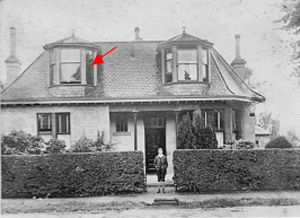 JLB’s home in Helensburgh, “The Lodge”, contained an immense number of books; he was strongly influenced by print before he ever started working on television.
JLB’s home in Helensburgh, “The Lodge”, contained an immense number of books; he was strongly influenced by print before he ever started working on television.
His father, the Rev John Baird, had become minister of the West Parish Church in 1868 and he bought the house in 1880. By this time he had built up a collection of theological books in Latin and Greek and German, and even Hebrew, which lined his study on the second floor of the house (see red arrow).
There were also books in English such as a volume of sermons by the great Scottish preacher Richard Baxter. Of more general interest there were multi-volume sets of encyclopedias and Victorian periodicals such as the Illustrated London News.
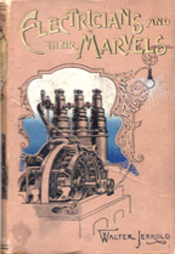 These had been published before the arrival of photo prints, and illustrated by woodcuts and charcoal etchings of very fine quality, small works of art in themselves.
These had been published before the arrival of photo prints, and illustrated by woodcuts and charcoal etchings of very fine quality, small works of art in themselves.
As a child in the 1890s, JLB was in frail health but he was a voracious reader. His interests in science and invention did not quite fit in with what was available at “The Lodge”, but the Pears Encyclopedia got him started, and then his mother would buy him books as birthday or Christmas presents.
I still have a popular science book called Electricians and Their Marvels, given to him by his mother for Christmas 1904. There were also the new books by H.G.Wells: “The Invisible Man”, “The War of the Worlds”, “The Time Machine”, and innumerable short stories.
There is an important passage from Wells’s “The Sleeper Awakes” about a young man called Graham who has a brain seizure while on holiday in Cornwall and goes into a sort of trance. He is kept alive for many decades and he wakes up in the far future without ageing in any way: he has in effect jumped ahead in time. Meanwhile he has become famous as “The Sleeper”.
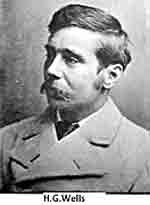 Then [Graham] turned to the square apparatus and … opened a sort of lid and found … a little stud like the stud of an electric bell. He pressed this and a rapid clicking began and ceased. He became aware of voices and music and noticed a play of colour on the smooth front face. He suddenly realised what this might be, and stepped back to regard it.
Then [Graham] turned to the square apparatus and … opened a sort of lid and found … a little stud like the stud of an electric bell. He pressed this and a rapid clicking began and ceased. He became aware of voices and music and noticed a play of colour on the smooth front face. He suddenly realised what this might be, and stepped back to regard it.
On the flat surface was now a little picture, very vividly coloured, and in this picture were figures that moved. Not only did they move, but they were conversing in clear small voices. It was exactly like reality viewed through an inverted opera glass and heard through a long tube.
His interest was seized at once by the situation, which presented a man pacing up and down and vociferating angry things to a pretty but petulant woman. Both were in the picturesque costume that seemed so strange to Graham. "I have worked," said the man, "but what have you been doing?"
"Ah!" said Graham. He forgot everything else, and sat down in the chair. Within five minutes he heard himself named, heard "when the Sleeper wakes" used jestingly as a proverb for remote postponement, and passed himself by, a thing remote and incredible. But in a little while he knew those two people like intimate friends. At last the miniature drama came to an end, and the square face of the apparatus was blank again.
It was a strange world into which he had been permitted to see, unscrupulous, pleasure seeking, energetic, subtle, a world too of dire economic struggle; there were allusions he did not understand, incidents that conveyed strange suggestions of altered moral ideals, flashes of dubious enlightenment … He sat staring at the blankness. He started and rubbed his eyes. He had been so absorbed in the latterday substitute for a novel, that he awoke with … more than a touch of surprise.
Here we have Wells in the Victorian era, describing not only a television set, but a soap opera and its hypnotic effect on the viewer. This passage would have been read by the young John Baird, and it may have put an idea in his head.
Not only was JLB a reader, but he was also an aspiring writer. He and his friends brought out a hand-written and rather scurrilous home made newspaper while he was a teenager at “The Lodge”.
When he became a student at the Glasgow and West of Scotland Technical College, he was a frequent contributor to the Royal Technical College Magazine. This was a well‑produced monthly (price 3d) which carried paid advertisements, editorials, news and comment, and some fiction.
Compared to modern student newspapers, the magazine reflected a more confident and dignified atmosphere. The College was churning out engineers and scientists for Britain's booming heavy industries, and for service in Canada, India, South Africa and other parts of what was proudly known as the Empire.
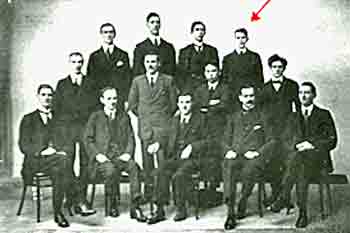 JLB wrote humorous articles over the pseudonym of H2O. These did not quite fit into the complacent scenario of the Magazine, but they may have been welcomed as comic relief. They were usually couched in a mock‑biblical style and dealt with the frustrations and trials of the engineering student, such as the laws of thermodynamics:
JLB wrote humorous articles over the pseudonym of H2O. These did not quite fit into the complacent scenario of the Magazine, but they may have been welcomed as comic relief. They were usually couched in a mock‑biblical style and dealt with the frustrations and trials of the engineering student, such as the laws of thermodynamics:
"The days of man are but few, and full of sorrow; soon is he cast down, and the mourners go about the streets. But a perfect gas expandeth for ever, from everlasting to everlasting , according to the equation: PV1.4 = C."
In 1913 JLB became the evening sub-editor of the magazine and he can be seen in this photograph (red arrow). Note the highly respectable appearance of the magazine staff, the dark suits, the ties, the well-polished shoes. They look like middle-aged men; and there are no women to be seen.
Fast Forward
Now a “fast-forward” through early television history including JLB’s experiments in Hastings to develop television, then his breakthrough in 1925, then the experimental broadcasts over the BBC starting in 1929, leading up to 1936 when the BBC adopted the Marconi-EMI all-electronic system, based primarily on US technology.
Throughout this frantically active period, JLB kept the world in touch with his research progress, via the print medium. Radio was a mass medium but he was never asked to broadcast on the BBC which tended to be suspicious of television.
However he did give a talk on radio when he was in the USA in 1931. He had this to say about the future of television: "Vast strides have been made and will be made in this new art. I myself look forward to seeing at no distant day, television theatres supersede the talkies, and the home television become as common as the home radio is today."
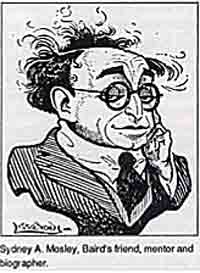 Although JLB had little time to write articles for the papers, he often gave interviews and he got along well with journalists one of whom, Ronald Tiltman, wrote a biography of Baird in 1933.
Although JLB had little time to write articles for the papers, he often gave interviews and he got along well with journalists one of whom, Ronald Tiltman, wrote a biography of Baird in 1933.
Another journalist was Sydney Moseley who promoted television aggressively in the London papers. Moseley also joined the board of Baird Television Ltd. and he wrote articles attacking the BBC for its hesitancy in taking up television. Not surprisingly the BBC’s director general, John Reith, could not stand Moseley.
At the beginning of World War Two, the BBC shut down its television service. Sales of television sets ceased and Baird Television Ltd. went into receivership. However JLB carried on with his television research, at his own expense and under difficult wartime conditions.
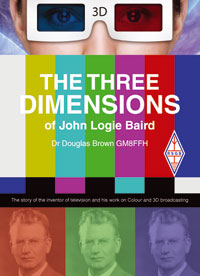 The technical details of his work on colour and 3D television are now coming to light, through the researches of Dr Douglas Brown; I hope I can be forgiven for plugging his new book The Three Dimensions of John Logie Baird, which was published in May 2012.
The technical details of his work on colour and 3D television are now coming to light, through the researches of Dr Douglas Brown; I hope I can be forgiven for plugging his new book The Three Dimensions of John Logie Baird, which was published in May 2012.
JLB’s wartime diary showed many appointments with journalists and he also organised demonstrations, for example, colour television in December 1940 and 3D television a year later. In 1944 he demonstrated a major breakthrough called “the Telechrome” which was the first colour cathode ray tube in the world.
Late in 1945 my sister Diana and I were allowed into his lab to see colour television, brighter and sharper than anything that had been seen before.
JLB had never enjoyed good health and he died in June 1946, just a week after the BBC reopened its television service. He had hoped that his ideas on high definition colour and 3D television would be put into practice after the war, but money was short and the BBC’s television service continued at the old 1936 standard with 405 lines of definition in black and white, with small pictures between 9 inches and 15 inches (22-38 cm).
Television sets were expensive and they carried a purchase tax of 66.7 %, reduced in 1948 to 33.3%. Television programmes were limited to a few hours per day, as in this example for Sept. 8 1952:
The programmes were low-budget productions and their impact was small, even after the service had been extended from London to the midlands and the north of England, and eventually to Scotland in March 1952. At that time, only about 3700 Scottish households had television licences; there were just 10 licence holders here in Helensburgh.
The Impact of Television
In June of 1953 the impact started to increase for one main reason: the Coronation of Queen Elizabeth.
At “The Lodge”, my aunt Annie Baird had invited friends and neighbours to watch, and I remember sitting in the stuffy atmosphere of my grandfather’s booklined study, with the windows closed and curtained, watching the royal events in flickery black and white on a 12 inch screen — and having to go out into the garden after an hour or so, with a splitting headache.
The impact of television continued to grow in 1955 when ITV started broadcasting and a badly-needed element of competition was introduced. Television discovered its youth audience and it introduced shows like “Top of the Pops” and “Doctor Who”.
As more and more people watched television, the print medium suffered, in particular the weekly and monthly magazines such as Illustrated, Picture Post, Lilliput and the venerable Strand Magazine which dated back to the 19th century. The tabloid newspapers such as the Daily Mirror and Daily Express, which relied heavily on pictures, gradually lost readership.
Here in Scotland that fine little paper, The Bulletin, closed in the 1950s. However the medium that suffered even more than print was film — many local cinemas closed because of dwindling audiences, and fewer films were made.
At this point I should distinguish between cultural impact on the viewer, and technical factors.

In an ideal world we might expect these two impacts to follow the same trends as the years go by; but this has not been so. Prior to 1953, the cultural impact lagged behind the technical impact for the simple reason that set ownership was expensive and television was not seen as a necessity. In Britain, the cultural impact grew sharply round about the time of the Coronation, even though there was no major improvement in technology.
For 25-30 years after the arrival of colour in 1967, there was a period which is often called the “golden age” of television. By this time the technology was highly advanced and the broadcasters still had the resources and the will to produce great programmes — documentaries, dramas etc.
Most notably these included brilliant adaptations of classics, for example the books of Jane Austen, A.J.Cronin, Charles Dickens, Conan Doyle, Evelyn Waugh, Anthony Trollope and P.G.Wodehouse. And there were great works by new dramatists such as Dennis Potter.
It is odd that television has largely ignored the works of H.G.Wells, who foresaw it over 100 years ago. And yet, Wells’s stories were successfully adapted as films, both in the UK and the USA.
Technical and cultural impacts
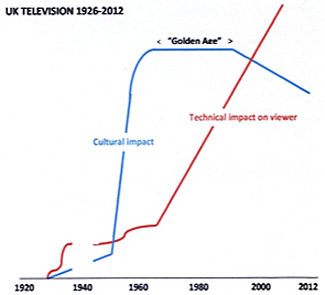 The impacts are summarized in a diagram showing two coloured lines plotted versus time, from 1926 to the present. These curves are merely a qualitative interpretation, to show the trends.
The impacts are summarized in a diagram showing two coloured lines plotted versus time, from 1926 to the present. These curves are merely a qualitative interpretation, to show the trends.
Technically (red line) television has continually improved, although there was a slow period between the end of the war and about 1964. Since then, there have been major improvements due to higher definition, satellite TV, colour, and a huge increase in the number of channels.
Culturally (blue line) growth was slow at first but it took off at the time of the Coronation; the impact reached a plateau during the “golden age” but since about 1995 there has been a slow decline; the television boom is running out of steam.
Although viewer numbers overall are still high, the viewing audience has been fragmented between an increased number of channels and this has placed strains on the budgets of the programme makers.
In my home country of Canada, television is treated as background — in the same way as we turn up the heating on a cold day. Perhaps this is an example of the old proverb: familiarity breeds contempt.
The UK has taken television more seriously, but I get the impression of a growing disenchantment with television programmes.
Here is part of an article about BBC current affairs in the conservative intellectual weekly The Spectator from July 3: ”The BBC ... is hideously monocultural. Its programme makers … display metropolitan liberal bias which is not shared by the majority of its audience. It is not so much a left-wing bias, per se, as a sort of complacent assumption that its own opinions are civilised and decent, and those which contrast with them are not merely wrong and beyond the pale, but not even worthy of articulation.” [Rod Liddle]
At a more grass roots level, I found this in The Sun (August 5): "Hairy Dieters, BBC2, 8pm. Hairy Bikers Si and Dave spend eight years piling food into their gobs but just at the moment everyone's wondering 'What's the bleedin' point?' the Beeb puts them on a diet. That whirring noise you can hear is from John Logie Baird's grave."
In the field of drama, British television still has a high reputation in North America, thanks to dramas such as All Creatures Great and Small, Sherlock Holmes, Jeeves and Wooster, Monarch of the Glen and Foyle’s War. The recordings on DVD are selling steadily. However, many of these programmes date back to the Golden Age before the drama budgets were cut.
Television, print and McLuhan
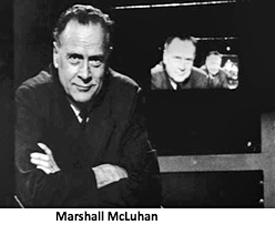 Television has had a terrific impact over the past 50 years, but print is still the dominant communications medium in most of the important areas of life: serious books and non-tabloid newspapers, legal and political documents, business and commerce, operating instructions for vehicles and appliances, forms of advertising where detail is important — and above all, education and research.
Television has had a terrific impact over the past 50 years, but print is still the dominant communications medium in most of the important areas of life: serious books and non-tabloid newspapers, legal and political documents, business and commerce, operating instructions for vehicles and appliances, forms of advertising where detail is important — and above all, education and research.
In spite of television, children still learn to read and write (up to a point anyway), university students study printed textbooks and take written exams, and if they go on to do advanced research their results appear in printed journals.
In the 1950s there was a lot of brave talk about educational television, and at first the BBC had hoped that television would harmonise with its original mission set out by Reith, “to educate, inform and entertain”. In the USA, the educational PBS network had some notable successes (e.g. the National Geographic series) but now it has to rely largely on private donations.
There are obviously fundamental differences between print and television. The first person to analyse these differences was the Canadian thinker Marshall McLuhan (1911-1980), who had studied at Cambridge with F.R.Leavis, and in his later life headed up his own institute at the University of Toronto.
He pointed out that print was a “hot” medium. Television in its early days was a “cool” medium, but larger and sharper pictures convey more information and it can be “hot” — but much depends on the way the programmes are made. This table helps us to understand the terms “hot” and “cool” as applied to media.

This concept can explain the often disappointing nature of television documentaries. Given a clear sharp picture, television can convey precise information (as in a hot medium) as long as the viewer is not distracted. However, most modern documentaries have a presenter who is encouraged to project his or her personality into the programme. The same comment applies to television news and even weather reports.
Today’s television programmers are under pressure to increase viewer numbers, so the presenter must involve the viewers rather than leaving them to take in the raw information on its own. In short, modern television tends to become a “cool” medium.
This also explains the difficulties with television as an educational medium. For example, an algebra class on educational television inevitably becomes a “cool” performance by the presenter; a good presenter can stimulate the viewer to take up algebra independently in a “hot” sort of way (e.g. via books and practice problems), but the programme itself is “cool”.
In The Global Village McLuhan suggested that the growth of broadcast television might lead to a unified tribal culture, with the world sitting around its electronic camp fire. I was strongly reminded of this by the televised closing ceremony of the 2012 Olympic Games, with the flaming cauldron dominating the arena to the primitive beat of the pop music. The words of the songs were unintelligible and perhaps they did not even matter for the international audience.
This tribal television society was predicted in George Orwell’s 1984. Ray Bradbury in Fahrenheit 451 envisaged a future in which all books were destroyed by government decree. McLuhan’s Global Village is a stark contrast to the print-based culture of the 19th and 20th centuries which has allowed for more individual publication of ideas.
What about the internet? McLuhan did not live to see it, but nevertheless he foresaw something like it: “The next medium, whatever it is — it may be the extension of consciousness — will include television as its content, not as its environment, and will transform television into an art form. A computer as a research and communication instrument could enhance retrieval, obsolesce mass library organization, retrieve the individual's encyclopedic function, and flip into a private line to speedily tailored data of a saleable kind.” (1962)
Well, after 50 years the internet has arrived. With it has come a cornucopia of electronic enhancements of traditional communication. For example electronic publishing of books (Kindle) is a major challenge to conventional publishing, and visual phones (Skype) have added a new dimension to an old technology. Video games are a form of interactive television and they demand complete involvement of the player; they can become addictive.
But on the whole, the internet functions as a text medium with email taking the place of letters and with most newspapers being accessible as web editions. Old video clips can be viewed on Youtube. If the viewer wants to pay a subscription, he or she can retrieve first-run films and television programmes.
Important features of the internet, not foreseen by McLuhan, are that individuals can freely choose between websites and express themselves in text (print). This is entirely counter to the “Global Village” type of culture with the world sitting around its electronic campfire, all getting the same message.
On the internet, individuals can open their own websites or just write blogs which are the electronic equivalent of “letters to the editor”. From my Canadian vantage point, I find the blogs invaluable in keeping an eye on social and political opinion in the UK, even allowing for the fact that bloggers are not a representative sample of the population!
In conclusion: for the time being, print holds the lead and we are not yet in the nightmare TV-dominated world envisaged by Orwell and McLuhan and others.
I for one am very glad of that; and I think that my father, who was an old-style individualist, would also have been glad that print is still in the lead, although conventional broadcast television still has a part to play in the media spectrum. However, unexpected things can happen in the world of technology.
As the old saying goes, “The only thing that is constant is change.”
- I am grateful to my son Iain Baird and Dr Richard G.Rice for constructive comments on the drafts of this article, which was delivered as a talk to Helensburgh Heritage Trust on Wednesday September 26 2012.




